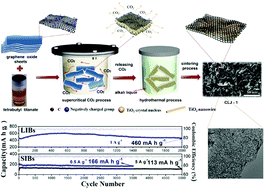A new strategy for the construction of 3D TiO2 nanowires/reduced graphene oxide for high-performance lithium/sodium batteries†
Abstract
Anatase TiO2 is inexpensive and potentially has high capacity as an Li+/Na+ battery anode, but its low capacity utilization and poor rate capability remain a challenge for practical applications. To address this issue, the fabrication of the 3D rational nanoarchitecture of anatase TiO2 nanowires (NWs) with desired size and microstructure on a reduced graphene oxide (RGO) host is an efficient and promising approach to meet the demand of high Li/Na storage and rate capability. However, to date, most of the reported anatase TiO2 NWs/RGO composites have been synthesized via the hydrothermal method and rarely investigated for Li+/Na+ batteries. Thus, herein, an innovative supercritical CO2 fluid-assisted strategy (SCFAS) is proposed for the synthesis of ultrafine TiO2 NWs/RGO composites. With the aid of the high permeability and superior solvability of supercritical CO2 fluid, the diameter of the ultrafine TiO2 NWs was well controlled at around 4.2 nm. Even at a high TiO2 loading (79.4 wt%), the TiO2 NWs still showed good dispersion and tight contact with the RGO host. As an anode material for Li-ion batteries, the reversible capacity of the as-formed composite remained 666 mA h g−1 after 300 cycles at 0.1 A g−1 and 460 mA h g−1 after 2000 cycles at 2 A g−1, which is nearly twice of that synthesized from the hydrothermal method. When cycled against Na, the reversible capacity was 113 mA h g−1 with 81.8% retention even at 5 A g−1 after 5000 cycles, which is better than other TiO2/RGO composites reported thus far. Noteworthy, this SCLAS method is universally suited for the construction of other 3D metal oxide/RGO nanocomposites for electrochemical energy storage.



 Please wait while we load your content...
Please wait while we load your content...